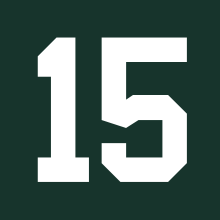Bart Starr
Shortly after the start of World War II, his father's reserve unit was activated and in 1942 he was deployed to the Pacific Theater.
[13] Starr attended Sidney Lanier High School in Montgomery,[14] and tried out for the football team in his sophomore year, but decided to quit after two weeks.
In his senior season, Starr was named all-state and All-American, and received college scholarship offers from universities across the country.
His high point of the season came in quarterback relief in the Orange Bowl, when he completed 8 of 12 passes for 93 yards and a touchdown against Syracuse.
[27] Johnny Dee, the basketball coach at Alabama, was a friend of Jack Vainisi, the personnel director of the Green Bay Packers.
[30][31] Starr spent the summer of 1956 living with his in-laws and throwing footballs through a tire in their backyard in order to prepare for his rookie season.
[33] Starr began as a backup to Tobin Rote in 1956 and split time with Babe Parilli until 1959, Vince Lombardi's first year as Packers coach.
In that season, Lombardi pulled starter Lamar McHan in favor of Starr, and he held the starting job henceforth.
The following season, the Packers advanced to the 1960 NFL Championship Game, but lost to the Philadelphia Eagles in Lombardi's only post-season loss as a head coach.
Even though Starr was not the focal point of the Packers' offense, with the running duo of Jim Taylor and Paul Hornung, he still provided a solid passing attack, throwing for a career-high 2,438 yards and 14 touchdowns, leading the league with a completion percentage of 62.5.
In 1964, with Jim Taylor and Paul Hornung struggling to continue their strong running game, Starr started to become more of the focus of the Packers' offensive attack.
Vince Lombardi would help this shift by acquiring more capable pass catchers to the offense, trading for receiver Carroll Dale to join with Boyd Dowler and Max McGee, replacing tight end Ron Kramer with Marv Fleming, and drafting more pass-catching running backs in Elijah Pitts and Donny Anderson.
On a sloppy Lambeau field, the Packers went back to their classic backfield tandem of Taylor and Hornung, with the pair running for over 200 yards.
Starr had another solid game against the Chiefs, throwing for 250 yards and two touchdowns, both to Max McGee, in a decisive 35-10 Packers win.
In the divisional playoff against the Los Angeles Rams, Starr was back in form, throwing for 222 yards and a touchdown pass in a 28-7 Packers triumph.
This victory would set the stage for the infamous Ice Bowl against the Dallas Cowboys in the 1967 NFL Championship Game.
[40] Starr won his second consecutive Super Bowl MVP award for his performance, where he threw for 202 yards and a touchdown pass, a 62-yard strike to Boyd Dowler.
Starr had originally planned to retire after the second Super Bowl win in January 1968, but without a clear successor and a new head coach, he stayed on.
After Lombardi's departure, Starr continued to be a productive quarterback under new Packers coach Phil Bengtson, though injuries hampered him.
Starr struggled to stay healthy again in 1969, but still once again led the league with a 62.2 completion percentage and an 89.9 passer rating, but only threw for 9 touchdowns and 1,161 yards.
When Devine left for Notre Dame after the 1974 season, Starr was hired as head coach of the Packers on Christmas Eve.
[52][53][54] Upon taking the job, he recognized the long odds of a Hall of Fame player becoming a successful head coach.
They defeated the St. Louis Cardinals 41–16 in the expanded wild card round of 16 teams on January 8, 1983–their first home playoff game since 1967.
After a disappointing 8–8 finish the following year, Starr was dismissed in favor of his former teammate Forrest Gregg, who previously led the Cincinnati Bengals to Super Bowl XVI in the 1981 season and had coached the Cleveland Browns prior to that.
[57] On January 13, 1984, Starr was named the head coach of the Arizona Firebirds, a proposed expansion team for the NFL in Phoenix.
[61] On October 17, 1970, President Richard Nixon spoke at a testimonial reception honoring Bart Starr in the Brown County Veterans Memorial Arena in Green Bay, Wisconsin.
The Athletes in Action/Bart Starr Award is given annually, by a panel of judges, to an NFL player who best exemplifies outstanding character and leadership in the home, on the field, and in the community.
[2] Starr even donated the Corvette he received as MVP of Super Bowl II to help Rawhide during their early years.
[77] He managed to attend a ceremony at Lambeau Field on November 26, 2015, retiring QB Brett Favre's jersey number,[78] and a fall 2017 reunion of the Ice Bowl Packers.
[79] Starr died at the age of 85 on Sunday, May 26, 2019, in Birmingham, Alabama after a period of failing health caused by a serious stroke he suffered in 2014.


